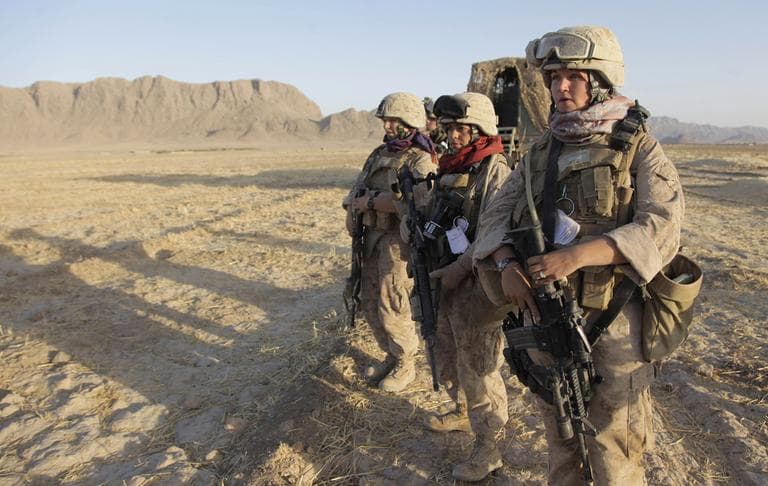Advertisement
Women On The Front Lines
We’ll look at the Pentagon’s announcement that American women will move closer to combat roles on the front lines of war.

American women in the U.S. military are formally barred from being assigned to direct combat roles. But in Iraq and Afghanistan, that line has become kind of a joke. Women now make up fifteen percent of the U.S. military. They are all over in wars without clear front lines. When your transport column is under fire, you’re in combat. When you’re on foot, in uniform and armed in Khandahar, you’re in combat country.
Now the rules are changing, slightly. Should they change a lot? Or not?
This hour, On Point: women and combat in the US military.
-Tom Ashbrook
Guests
Eric Schmitt, a senior writer who covers national security for the New York Times.
Andrew Tilghman, senior writer, Military Times.
Margaret Harrell, senior fellow and the Director of the Joining Forces Initiative at the Center for a New American Security.
Kayla Williams, served in an Army interpreter in Iraq from 2003 to 2004, author of Love My Rifle More than You: Young and Female in the U.S. Army. She is now a project associate with the RAND Corporation.
Robert Maginnis, a retired Army lieutenant colonel, he is a senior fellow for national security at the Family Research Council.
Highlights
“I took part in the initial invasion of Iraq in 2003 and went out on foot patrols with the infantry in Baghdad. I had no plates in my flack vest because they assumed that since I was a female, I wouldn’t need them,” said Kayla Williams, who served in an Army interpreter in Iraq from 2003 to 2004. “During combat operations, my gender was never an issue.”
As the military shrinks in size, commanders will need even more flexibility to move different soldiers to different jobs, relaxing the restrictions on women can do just that, said Margaret Harrell, senior fellow at the Center for a New American Security. She said that none of the commanders in Iraq and Afghanistan report problems from having female soldiers on the field of battle.
Others are critical of the decision to allow women into combat. “I don’t think that we should dismiss the fact that young people bring their libidos with them into the battlefield and that becomes a factor that we have to seriously consider, said Robert Maginnis, a retired Army lieutenant colonel and a senior fellow for national security at the Family Research Council. He said that the presence of both sexes on the battlefield can lead to sex, pregnancy, and morale issues with military units.
Advertisement
While women in combat may be point of debate outside the military, inside things look different. “This isn’t a huge issue inside the military at this point,” said Andrew Tilghman, senior writer at the Military Times. He said that the changes would have the most impact on the Army, which has tried to maintain a ban on women in combat. But in others services, it will not mean that much change. The Marines, for instance, long ago included women in their frontline units.
From Tom's Reading List
The New York Times "The Army, it is said, ain’t what it used to be — and it never was. Nowhere is that more apparent than in the policies governing women in combat, whose role has increased as steadily as the military and the very nature of war have changed. "
Christian Science Monitor "The Pentagon Thursday cracked open the door for women to serve in combat, though they will still not be permitted to fight in battle – at least officially."
National Journal "Female troops have been informally serving alongside combat units in Iraq and Afghanistan for years, and roughly 150 have been killed to date in the two war zones. The changes announced on Thursday will still bar them from serving in infantry units or elite forces like the Navy SEALs. But they will open up more than 14,000 other positions to women, making it easier for large numbers of women to serve as frontline medics, helicopter pilots, and intelligence analysts."
This program aired on February 13, 2012.